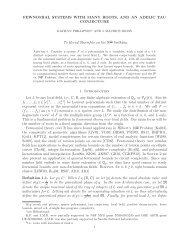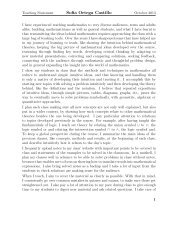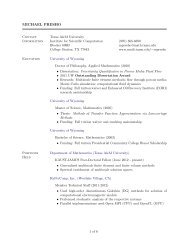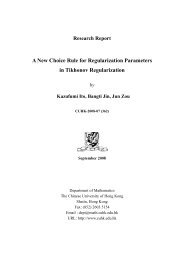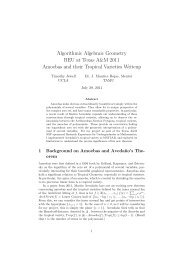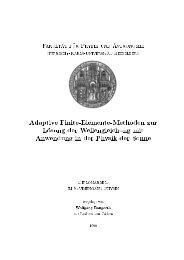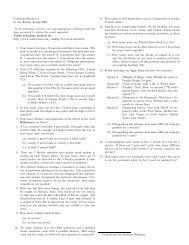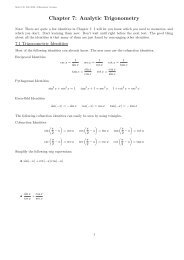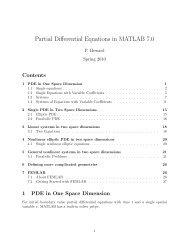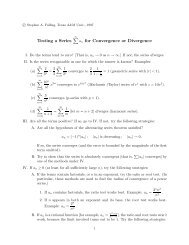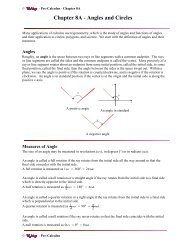Tensors: Geometry and Applications J.M. Landsberg - Texas A&M ...
Tensors: Geometry and Applications J.M. Landsberg - Texas A&M ...
Tensors: Geometry and Applications J.M. Landsberg - Texas A&M ...
Create successful ePaper yourself
Turn your PDF publications into a flip-book with our unique Google optimized e-Paper software.
0.5. Conventions, acknowledgments xix<br />
The st<strong>and</strong>ard reference for what was known in algebraic complexity theory<br />
up to 1997 is [53].<br />
0.5. Conventions, acknowledgments<br />
0.5.1. Notations. This subsection is included for quick reference. All notations<br />
are defined properly the first time they are used in the text.<br />
Vector spaces are usually denoted A,B,C,V,W, <strong>and</strong> Aj <strong>and</strong> the dimensions<br />
are usually the corresponding bold letters a,b,c etc... If v1,... ,vp ∈ V ,<br />
〈v1,... ,vp〉 denotes the span of v1,... ,vp. If e1,...,ev is a basis of V ,<br />
e 1 ,... ,e v denotes the dual basis of V ∗ . GL(V ) denotes the general linear<br />
group of invertible linear maps V → V <strong>and</strong> gl(V ) its Lie algebra. If G<br />
denotes a Lie or algebraic group, g denotes its associated Lie algebra.<br />
If X ⊂ PV is an algebraic set, then ˆ X ⊂ V is the cone over it, its inverse<br />
image plus 0 under π : V \0 → PV . If v ∈ V , [v] ∈ PV denotes π(v). The<br />
linear span of a set X ⊂ PV is denoted 〈X〉 ⊆ V .<br />
For a variety X, Xsmooth denotes its smooth points <strong>and</strong> Xsing denotes its<br />
singular points. Xgeneral denotes the set of general points of X. Sometimes<br />
I abuse language <strong>and</strong> refer to a point as a general point with respect to<br />
other data. For example, if L ∈ G(k,V ) <strong>and</strong> one is studying the pair (X,L)<br />
where X ⊂ PV is a subvariety, I will call L a general point if L is in general<br />
position with respect to X.<br />
Λ k V denotes the k-th exterior power of the vector space V , the symbols<br />
∧ <strong>and</strong> � denote exterior product. S k V is the k-th symmetric power. The<br />
tensor product of v,w ∈ V is denoted v⊗w ∈ V ⊗2 , <strong>and</strong> symmetric product<br />
has no marking, e.g., vw = 1<br />
2 (v⊗w + w⊗v). If p ∈ Sd V is a homogeneous<br />
polynomial of degree d, write pk,d−k ∈ S k V ⊗S d−k V for its partial polarization<br />
<strong>and</strong> p for p considered as a d-multilinear form V ∗ × · · · × V ∗ → C.<br />
When needed, ◦ is used for the symmetric product of spaces, e.g., given a<br />
subspace W ⊂ S q V , W ◦ S p V ⊂ S q+p V .<br />
Sd denotes the group of permutations on d elements. To a partition<br />
π = (p1,... ,pr) of d, i.e., a set of integers p1 ≥ p2 ≥ · · · ≥ pr, pi ∈ Z+, such<br />
that p1 + · · ·+pr = d, [π] denotes the associated irreducible Sd module <strong>and</strong><br />
SπV denotes the associated irreducible GL(V )-module. I write |π| = d, <strong>and</strong><br />
ℓ(π) = r.<br />
0.5.2. Layout. All theorems, propositions, remarks, examples, etc., are<br />
numbered together within each section; for example, Theorem 1.3.2 is the<br />
second numbered item in Section 1.3. Equations are numbered sequentially<br />
within each Chapter. I have included hints for selected exercises, those<br />
marked with the symbol ⊚ at the end, which is meant to be suggestive of a<br />
life preserver.



